A dedication to Bultaco Trial Motorcycles:
This Trials Guru special section is dedicated to the Bultaco brand created by the founder of the limited company called: Compañia Española De Motores in the town of Sant Adrià de Besòs, a municipality of the city of Barcelona, Spain. The founder being the forward thinking and passionate motorcycle competitor Francesco Xavier Bultó, from where the Bultaco name was coined. The trade mark CEMOTO was an acronym of the company name Compañia Española de Motores.


The ‘Sherpa T’ is born:
‘Paco’ Bultó as he was known, had been in partnership with Pere Permanyer in the company Permanyer and Bultó which manufactured the rival Montesa brand. After a disagreement, which resulted in the withdrawal of Montesa from racing, and therefore change the direction of the business, Bultó dissolved the partnership with Permanyer and eventually set up his own company in 1958. This was staffed by ex-Montesa employees who had great respect for Bulto. He had been persuaded by the support of the Montesa racing department staff who helped set up the new enterprise.
Bultó’s son, Ignacio explained to Trials Guru’s John Moffat in June 2017 that it was a long story but it involved nephew’s of his mother who F.X. Bultó had secured employment for at the Montesa factory. It appeared that they had reported Bultó as wasting money with the company’s racing enterprises, this annoyed Bultó as the board had taken decisions behind his back when he had been on a business trip to the USA to secure supplies of piston rings. This was to signal Bulto’s departure from the board of ‘Permanyer and Bultó’.
However this eventually led to a fierce rivalry between the two organisations as the years progressed. F.X. Bultó was a sporting motorcyclist, he was a former competitor and had ridden in events such as the International Six Days Trial, he attended the Isle of Man TT races, racing was in his blood.
The initial launch model 1, the Bultaco Tralla 101 was made in 1959 at the Bultó farm called San Antonio before moving to the factory at Sant Adrià de Besòs, sometime later.
Bultaco produced small capacity two-stroke machines for road use, but it’s heart lay in competition. Paco Bultó being a fan of the TT Races had always been keen to develop the TSS models for road racing.
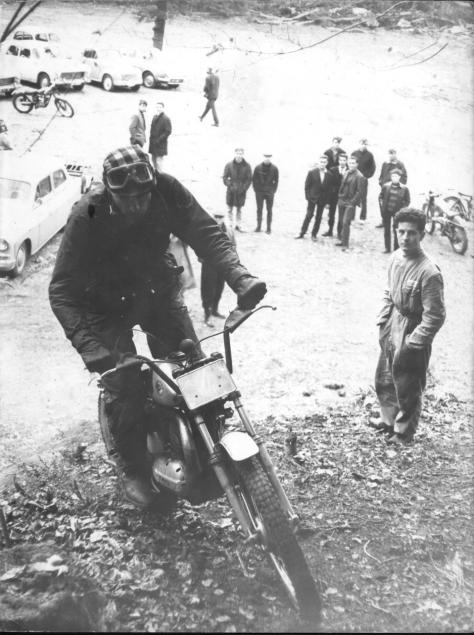
The firm produced the Sherpa models for off-road use. The Sherpa N (model 4) was a dual purpose ‘trail’ machine powered by the firm’s 155cc then later their 196cc single cylinder two-stroke motor.
It was this model that became the basis for the Sherpa T, developed first by the founder’s nephew, Juan Soler Bultó and then taken to new heights by the engagement of Sammy Miller as a development rider. Miller was contracted to develop and ride for Bultaco, this was announced in the motorcycle press in the October of 1964, but secret testing and improvements made to the prototype Bultaco had taken place several months earlier, in company with his friend Roy Peplow, when Miller was still contracted to Ariels. The initial introduction of Sammy Miller to F.X. Bultó was made by Harry Lindsay, the Dublin motorcycle dealer and entrepreneur who imported the Bultaco brand to Ireland.

Sammy Miller insisted that the motor used be enlarged to that of a two-fifty from 196cc for trials use and the original development Sherpa was close enough at 244cc using a 72 mm bore and 60 mm stroke with a wheelbase of 51.5 inches.

The early Sherpa motor was a four-speeder with a distinctive ‘radial’ finned cylinder head. Miller’s first big win on his 1964 prototype/development Sherpa (registered as 669NHO in November 1964, in Hampshire) which would later be produced as the Sherpa T was unquestionably the 1965 Scottish Six Days Trial in the May that year. The SSDT was rated as the toughest test of a trials machine in the world and the win would generate volume sales for the Spanish concern. Miller’s victory, carrying number 156 on the development Sherpa finally signalled the end of the heavyweight four-stroke trials machine, consigning them to museums and raised the bar for all two-stroke trial machine manufacturers.
The 1965 production model 10 Sherpa T was undoubtedly a true Sammy Miller replica. In 1959, Royal Enfield in the UK produced their Bullet trials model ‘works replica’ and so Bultaco followed suit with their true ‘works replica’ in Miller’s name.

Derek Cranfield, formerly of Comerfords and a close friend of Reg May said: “Regarding Reg May’s first Bultaco, I was working with Reg at Comerfords when the first batch of Sherpa machines arrived in the country at Rickman Bros. We were notified about 9.30am and when we arrived at Rickmans we found Sammy Miller putting the machines together. At that time you had to have a different frame and engine number to save on purchase tax, this was called ‘Kit Form’. Reg wanted the first machine himself, got Sam to fire one up, and that it was a good one. I took the frame and engine numbers, phoned Comerfords and got them to go straight to the vehicle tax office and register it. I think we can say that other than Sam’s this was the first Bulto registered“.
Miller: “I don’t listen to stories, I’m only interested in facts”
In an interview at the Scottish Motorcycle Show in March 2001, Sammy Miller told Trials Guru representative, John Moffat: “John, I don’t listen to stories, I’m only interested in facts! The Pre’65 movement did not just happen, I know some people take the credit for coining the phrase, but it was really not pre’65 it was ‘post Sammy Miller goes to Bultaco’. When I moved from Ariels and all the secret testing that had gone before in a ‘hush-hush’ manner, this signalled a sea-change in motorcycle trials. When I moved to Bultaco the game changed completely and that allowed the birth of what we now know as pre’65 trials“.

The first UK importer of the Bultaco Sherpa T was the Rickman Brothers, Don and Derek based in New Milton, Hampshire who were the makers of Metisse motocross frame kits and already had an association with the Spanish company through motocross. Rickmans developed the Bultaco engined Metisse adopted by Bultaco as their model 11 in 1964 before the production of Bultaco’s own motocross ‘Pursang’ first in prototype form as the model 25 then the Pursang Mk2 model 42 in 1967.

Miller’s 1965 SSDT victory was to be repeated again in 1967 and 1968, the 1966 trial was won by Alan ‘Sid’ Lampkin the middle Lampkin brother on his factory BSA C15T (748MOE). However Lampkin himself would be Bultaco mounted some short years later and so would his younger brother H. Martin Lampkin, who would take Bultaco to a new height, that of the first World Trials Champions in 1975.

The introduction of the first four-speed, 244cc Sherpa T model was to revolutionise the trials world when sold to the public. Known in Spain as the ‘model 10 – Sammy Miller’. Modest riders found the machine nimble, controllable and tractable, with only minor adjustments, straight from the crate. Many riders of the day felt that riding the Sherpa in competition improved their results.

Miller was so confident in the Bultaco Sherpa T that he had a clause written into his factory contract that if he didn’t win fifty percent of the events entered, then Bultó did not have to pay him!
Straight from the Sherpa N model, the Sherpa T was produced with a forward mounted front wheel spindle, which was very helpful in eliminating ‘tuck-under’ on steep drops in sections. The front wheel spindle location was retained throughout the Sherpas entire production run. The front forks were made by the Spanish suspension manufacturer Betor to Bultacos specification. It is believed that the rival ‘Telesco’ concern made some 32mm front forks fitted to some Bultaco models. However, Bultaco maintained a strong connection with the Betor concern right up to their demise of Bultaco in 1985 with the final model 199B Sherpa T fitted with Betor units.
Development was at the forefront of Paco Bultó’s mind, he was never a man to rest on his laurels, so subtle changes were made to the Sherpa T and a second series production model 10 with a revised fuel tank for late 1965, early 1966. This was followed in 1967 by a new model with a five-speed gearbox to which the gear shaft position was moved more forward and protruded through the primary chaincase, whereas the model 10 had a separate small casing at the rear of the primary casing. It also had a more conventionally finned cylinder head and was referred to as the Sherpa T model.27, known in Spain as the ‘San Antonio’ as the motor was nick-named as such during development and after Bultó’s ranch.

Miller had sold his original prototype (669NHO) and used his prototype model 27 (EAA60D) to win the 1967 & ’68 SSDT followed by his prototype model 49 (ROU5G).



Miller’s prototype, EAA60D is now owned and fully restored by Yrjo Vesterinen.


In preparation for the 1968 season, Bultaco released the Sherpa T model 49, which had three production series with detail changes. The preceding model, the type 27 – ‘San Antonio’ was the first production five-speed Sherpa T and is now a highly collectible variant, given its relatively short production run.



Miller’s win in 1965 was not the first outing for a Bultaco at the Scottish Six Days. Lancastrian Tommy Ollerton, in company with Oriol Puig Bultó had ridden Sherpa N models, heavily modified in the event.
Oriol Puig Bultó spoke with Trials Guru in 2013: “I drove a little 500cc Seat car with a two moto trolley (twin bike trailer) all the way from the factory at San Adria de Besos to Edinburgh in 1964 for the Scottish. It was a long way to drive overland and a great adventure for me to promote the Bultaco. I had one moto for me and the other for Tommy Ollerton to ride in the six days”.
Tommy Ollerton was a Lancastrian trials rider who had an association with John Anelay Motorcycles of Blackburn. Ollerton had a 196cc Sherpa S at his disposal and much work was done to improve the machine prior to Sammy Miller’s arrival at Bultaco, Spain. His modified Sherpa S, which was built as a motocross model and coded as model 3 by the factory, was registered PBV700 in Blackburn, Lancashire. It was with this machine that he rode the 1962 Scottish Six Days Trial, carrying number 8. Tom Ollerton was therefore the first rider ever to enter and finish the Scottish Six Day Trial on a Bultaco machine.
John Anelay was a former racer himself and built his own racing machines which were entered in the Isle of Man TT, ridden by supported riders. Anelay became friends with Paco Bultó and when Anelay ceased his involvement with racing, gave his own racing engine to Bultó which helped Bultaco develop their own two-stroke motor.
Prior to Ollerton’s Sherpa S, road racer Dan Shorey had been riding a Bultaco Sherpa N (model 4) in trials as early as 1961. Many road racers made use of a trials machine over the winter months to keep fit and using the section line, many claimed it kept their ‘eye in’. Shorey’s machine was registered UBW677 and was supplied from the Bultaco factory for his use. It was modified at his father Bert Shorey’s North Bar Garage in Banbury, Oxfordshire. Dan Shorey raced Bultaco Trallas for the factory at that time, hence the connection.
Much rhetoric over the years surrounding the Bultaco Sherpa suggests that Sammy Miller did not develop the Sherpa, that is only correct to a point in time. It is correct that the original ‘Sherpa N’ which started out life as the company’s dual purpose off-road model, developed from the road-going Tralla model was developed in Spain by Bultaco employees, engineers and Bultaco family members, with testing carried out by Oriol Puig Bultó and Juan Soler Bultó. Both the Sherpa N & S models were released to the public for sale in 1960. Paco Bultó was keen to build a purpose built trials machine and Sammy Miller was approached. However, it was without doubt, that it was Sammy Miller who took the Sherpa development project so much further and transformed the Sherpa N into the Sherpa T and subsequently changed the face of motorcycle trials forever.
Sammy Miller was by 1964 a national trial winner and had won the Scottish Six Days twice on his Ariel. It needed a rider of Miller’s ability and stature to take the Bultaco Sherpa to a new level, that of national and international victory. This ensured the success and ultimate demand for the Barcelona company’s product.
Bultaco didn’t have it all their own way of course, their rivals, Montesa had returned to competition, particularly motocross with Pere Pi and had developed their 247cc Cota trials model from 1967. Their main riders were England’s Don Smith who became European Trials champion and Frenchman Christian Rayer who gave Miller a run for his money on the European scene. The British Greeves factory also campaigned it’s Anglian model with the ageing Villiers powerplant in the capable hands of Gordon Farley, Gordon Adsett, Bill Wilkinson and a young Yorkshireman called Malcolm Rathmell. However most of these riders were to defect to Spanish marques eventually.
Bultaco Sherpa T – The Riders and Achievements:

Malcolm Charles Rathmell was both a scrambles and trials rider and was signed in 1970 to ride Bultacos in motocross, switching fully to trials later that season. Rathmell was to debut a new prototype with the development of the ‘Kit Campeon’ or slimline Sherpa in 1970. He also debuted the 1974 ‘whispering wonder’ 325cc Sherpa which would enter production in 1975. Much of the testing carried out by Manuel Soler. Malcolm won the 1973 Scottish Six Days which the factory used in their promotional material.

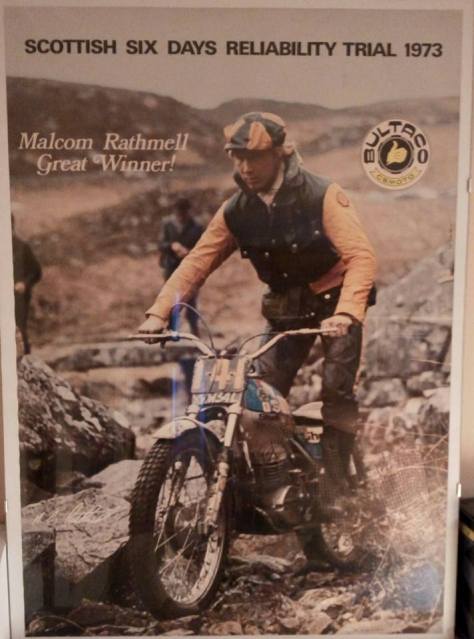
On the home front, Bultaco Spain had their own factory riders in the shape of Bultó’s son, Ignacio and his grand-nephew, Manuel Soler, both of whom became Spanish National Champions. Manuel’s nick-name was ‘El Monstruito’ which means ‘The Monster’. Soler won a round of the World Trials Championship in Vesterinen’s native Finland in 1979 at Espoo, near Helsinki riding a factory 199A Sherpa T.

Soler was the son of Juan Soler Bultó and had a special 100cc machine built for him called the ‘Mymsa’ and was a minaturised Sherpa on which he cut his trials teeth.

Manuel Soler told Trials Guru in 2013 when on a visit to Scotland: “The Bultaco factory was our garage, all our motorcycles were stored and worked on there by the firm’s mechanics. Even my little bike was there for a long time. When the factory closed, all my bikes and those of my cousin Ignacio were sold by the liquidators. I was a development rider and every day I tested Sherpas, made a written report and made suggestions on how to improve them, it was my job”.

The European Trials Championship which had been organised since 1964 and until 1968 it was called the Challenge Henry Groutards was the fore-runner to the World Trials Championship which commenced in 1975.

The winner of the very first world round in Ireland was Comerford Bultaco rider Dave Thorpe from Sheffield, England, but the series winner and first ever world champion was Bultaco factory rider, Martin Lampkin on his UK registered Sherpa GWX78N.
Dave Thorpe kindly allowed Trials Guru to display the very letter sent to him by F.X. Bulto on 17th February 1975, welcoming him as a works rider and congratulating him on his Hurst Cup win.



The North American market was important to Spain for exports and their balance of trade. Bultaco realised there was demand in the USA for trials machines, the sport was growing. Importers were appointed in the east and west coast and sales grew steadily.

Three times AMA Trials Champion Lane Leavitt, the tall Californian’s name became synonymous with the brand. Starting on a private machine to full works support. His machines were always interesting with many innovative ideas being tried and tested.


Lane Leavitt told Trials Guru in 2015: “The seat height on the ‘duel tank’ bike was about an inch lower than the ‘kit campeon’ Sherpa. This bike had the rear shocks moved forward about 1 and 1/2 inches, which worked very well. But the 4 inch further forward on my 1974 bike worked even better. It’s just the shocks of the day could not really handle the extreme forward location for very long“.


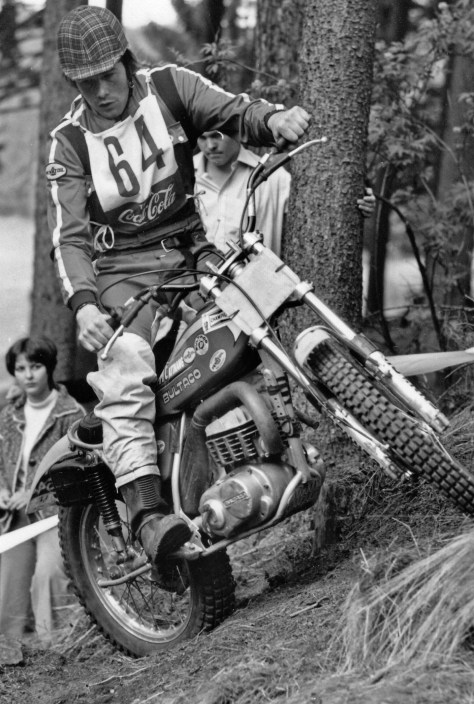
For the 1976 Wagner Cup world round in the USA, the Bultaco factory made their four top riders machines available for sale after the event. A unique opportunity to own a factory specification machine for the price of a production Sherpa.

In France the name Charles Coutard, son of Claude Coutard was making a name for himself in the French National championship and was also to become factory supported on the Sherpa.
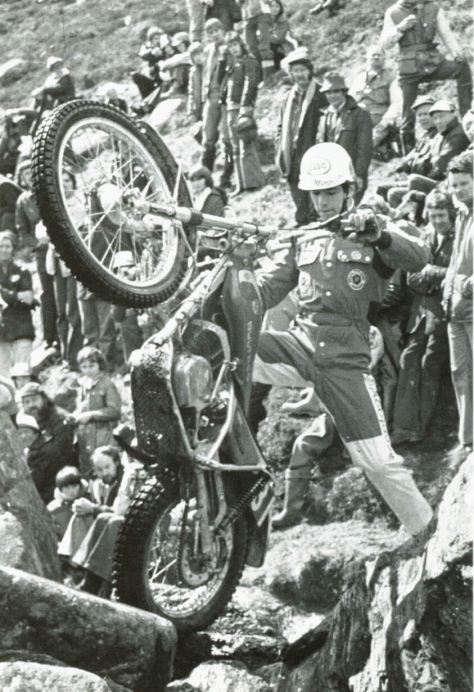
The very special Sherpa M.133

Bultaco were always experimenting and their competition department was a busy place when developing the Sherpa and Pursang motocross models. One such Sherpa, the 1974 model 133 is a very rare beast indeed.

It did go into a limited non-production run of only 13 machines, but it was used almost exclusively by the factory riders and regarded by the factory as a ‘prototype’ model. It was in essence a test-bed model for new ideas and it was under constant development with the factory riders feeding back information on a regular basis to the competition department. Much of these developments went into producing the later 190/191 model Sherpa whereas the model 159 (1975/76) was a direct result of the development work carried out by factory development rider, Manuel Soler. The model 133 did not directly influence the production M158/159 version which was a short chassis. The later M182/183 (1975-77) and M190/191 (1976-77) were in fact second and third generation M158/159 models. The revised model M198/199 (1077-1979) had the longer rear frame loop.

There are a few still in circulation, one of which is owned by former factory rider, Yrjo Vesterinen.


…
An interesting feature of the Sherpa 133 frame was the bolt-on footrest plate. This enabled an easy repositioning of the footrest position to suit the individual preference of the rider. The 133 frame changed over the 1974 season and it is thought the early version had a more distinct curved front downtube than later variants. It is also believed that frames were upgraded to test different versions, however this has not been confirmed. Another detail which was used on the 133, was the use of the earlier bottom steering yoke which was used on Sherpas up to 1972 and is not of the curved type and made from steel, not alloy. This was deemed to be a backward step in the Sherpa’s development. Obviously the factory used new/old stock for this component.

…

…
Vesterinen, Finland
In Finland, a young rider called Yrjo Vesterinen was about to burst onto the world-wide trials scene Bultaco mounted. His first Scottish Six Days was to be in 1974 on a borrowed 325cc Sherpa from UK importer Comerfords top technician, Reg May, himself regarded as a Bultaco tuning ‘wizard’ (see section further down).

Vesterinen was destined to become three times World Trials champion 1976-78 for Bultaco.

The following year, 1979 American number 1, Bernie Schreiber was to become the first American to win the title again for Bultaco who had dominated the World series since it’s inception in the 1975 season with Martin Lampkin taking the first title.

Schreiber had attended a Mick Andrews trials school in the early 1970s and was supported for a time by ‘Bay Area Bultaco’ based in Los Angeles, California. His riding style became more radical and he was the rider who developed what he called his ‘basic dab-less 180’ which was also known as the flick-turn. A new breed of rider was spawned due to Schreiber’s approach.
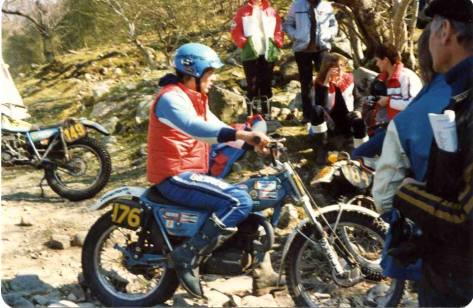

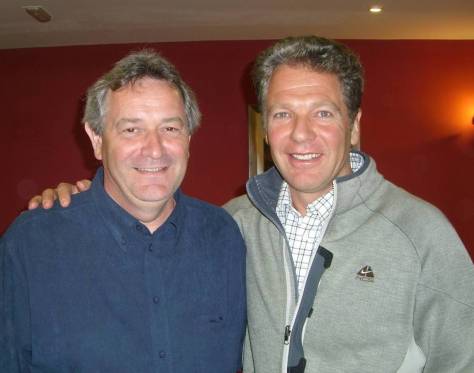
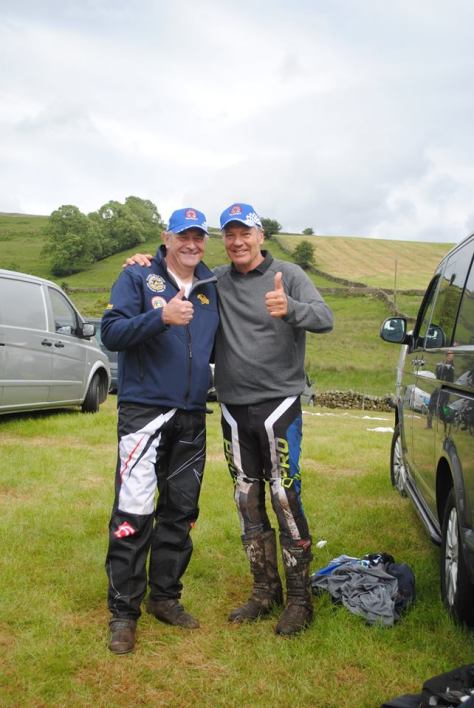
In Italy, Ettore Baldini was picking up Italian National Championships on his Sherpa.

Baldini rode Bultaco 1977-1980 winning the Italian Trials title in 1977 and 1979 and was a top 15 World Championship runner at that time.

Former ten times British Trials Champion, world round winner and four times Scottish Six Days winner and UK importer of TRS Motorcycles, Steve Saunders told Trials Guru in 2016:
“I have ridden a wide range of trials machines for the major factories in my career, but I have to say that my Bultaco days were absolutely fantastic. I have great memories of them. I won the ACU British Youth A class championships in 1980 and 1981 for Bultaco UK and the opportunity to work beside some heroes, such as Bernie Schreiber whom I learnt a lot from during practise sessions with him. Schreiber was based in Surrey at that period in time when he rode in Europe under Comerfords.”
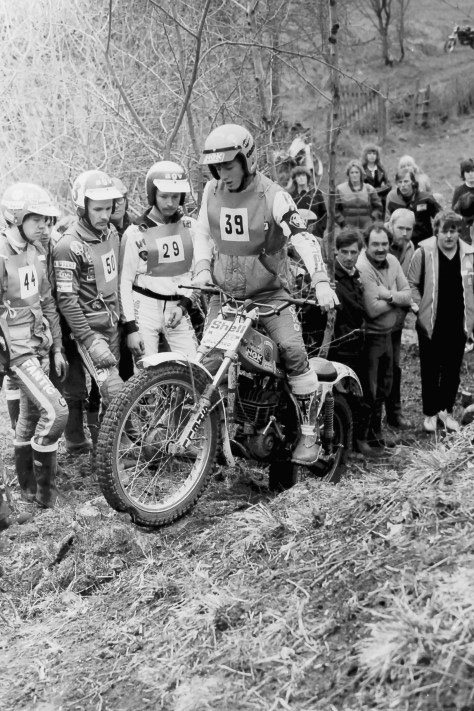
“I also learnt a lot about the mechanics of the trials machine as the great Reg May, the Bultaco tuning wizard, was preparing my bikes at Comerfords.
At this time of course I was competing on the 250 Bultaco Sherpa, as youths could ride 250cc machines, unlike now where they are limited to 125cc.

Steve Saunders: “We still have my father Dennis’s Bultaco Sherpa from when he rode in the early 1970s and my son James has ridden in some classic trials with it, it’s not for sale”.

The Sherpa T development:
Continuous model development was an ongoing process at Bultaco and the Sherpa model changed greatly over the years. From the time Sammy Miller was employed as their development engineer/rider there was no committees to answer to. The main person was Paco Bulto and if he said a modification was to proceed, then it did.
In 1971, the factory had retooled the production line and began to produce the Sherpa T ‘model 80’ with the new slimline one-piece tank/seat unit manufactured in fiberglass resin and a new style exhaust system that enabled the machine to be very narrow where the rider naturally stood on the foot-pegs. The factory name was the ‘Kit Campeon’ or championship kit. This kit was marketed to existing owners of Sherpa T model 49, which was produced in three series production runs, to upgrade their machines to the same specification of the new model 80 which replaced it.

Sammy Miller in the UK was by now well established as an after market supplier of trials equipment with his ‘Sammy Miller Equipe’, later called Sammy Miller Products. He had introduced a frame kit called the SM ‘Hi-Boy’ which dispensed with the cradle under the motor, using the motor as a stressed member of the frame. As well as retailing alloy exhaust centre boxes, Miller also marketed his own British made version of the ‘Kit Campeon’ produced in fiberglass resin, but was available in red/ivory; blue/ivory and green/ivory colour combinations. The Miller tank/seat unit also came with a bayonet type petrol cap thus distinguished from Bultacos own item. Sammy Miller’s after-market products offered the Bultaco owner a choice, thus assisting in ‘personalising’ the owners’ Sherpa T.


…

…
The UK specification models in 1973 and 1974 used the ‘Homerlite’ alloy tank seat unit, manufactured by A.J. Homer and Sons Ltd. of Solihull, England.

Another developer of the Bultaco Sherpa was Steve Wilson from the Midlands of England. An accomplished motocross, speedway and trials rider, Wilson built frame kits to take the Bultaco components.

Wilson built some very interesting Sherpas including a 125cc and a big bore 342cc variant of the Sherpa motor. Wilson framed Sherpas are highly sought after today.

Steve Wilson’s special 199A, he called ‘The Tanker’, bored out to 342cc and the fuel tank under the seat area was a very special machine.

In 1972, the production motor was subjected to some upgrading, not just the 244cc motor but the development of the 326cc motor both for trials and motocross.


Many riders were asking for more power so it was a natural development to produce a larger capacity engine for the Sherpa model 91 which ran from 1972 to early 1974.

Riders were by now feeding back information through importers and the factory riders direct.
The model 124 (250cc)/125 (325cc) introduced for the 1974 season which not only used the Pursang rear wheel hub made in two halves, but had the drive side of the swinging arm doubling as a lubrication oil reservoir for the final drive chain. Sammy Miller having manufactured and retailed a separate small aluminium chain oiler reservoir around the time of the Sherpa model 27 which utilised the top rear engine mount points. Many owners had purchased the Miller’s after-market chain oiler unit which was useful for long distance events to reduce chain wear.

Much of the testing was carried out by Bulto’s son Ignacio and grand-nephew Manuel Soler. In fact the models 158 (250cc) and 159 (325cc) Sherpa introduced in 1975 is known in Spain as the ‘Manuel Soler’ because of the input Soler had to this model and also the following Sherpa models 182/183 and 190/191.

The 158/159 models reverted to the separate tank and seat whereas models 80, 90/91; 124/125 and 150/151 all had combined tank/seat units in fiberglass resin for the home and USA markets. Aluminium versions were fitted by the United Kingdom importer, Comerfords due to the UK traffic laws at that time, which banned the use of non-metal fuel tanks.



These aluminium tanks were made in Birmingham, England by a company who used the brand name ‘Homerlite’.

A reduced capacity 238cc variant of the 244cc motor was used in 1976 in model 158, particularly for the French market due to their insurance and traffic legislation. This was referred to as the ‘238’ Sherpa.
Front forks were also changed over the years and in particular the steering yokes or ‘triple trees’ as they are known in the USA. In 1973 the lower yoke made out of aluminium became more curved and gripped the stantions lower down thus helping to stabilise the front forks and eliminate twisting and deflection of the front wheel during use.


In late 1979 the Sherpa model 199A had the swinging arm made with strengthening ‘gusset plates’ to eliminate bending, which the previous model 199 (1977-early 80) was susceptible to.


The 199A model had an achelles heel in that the air-box fitted as standard was to small in air volume. The factory riders were issued with machines fitted with earlier model 159 air-boxes to combat the problem.
Austrian heating engineer, Walther Wolf from Vienna, a friend of Puch & KTM factory rider Walther Luft, made his own aluminium alloy air boxes and these became very popular and highly sought after.

Model 221.

A new lease of life for the 150/151 chassis was achieved in 1979 when Bultaco launched a 175cc Sherpa, the model was numbered ‘221’ and was aimed at the UK youth market and the lower insurance bracket in France.

Using the 1975 chassis the motor was in fact a 238 fitted with a 175cc barrel, utilising the 60mm stroke. Finished in blue like the 199A, in the UK it was fitted with an alloy fuel tank, whereas European models had the polypropelene version and the 125cc model single seat and earlier airbox.
Comerfords the UK importer built this special 175 using a 340 chassis for supported rider, Yorkshireman, Brian Hutchison.

…

…

…

…
370 Sherpa.
It was not well known at the time, but factory rider Martin Lampkin used a larger than standard motor in his Sherpa, in effect a long stroke which was similar to and used the Alpina 348 long-stroke dimensions, but a larger piston. His factory machines were looked after by the UK importer, Comerfords technician, Reg May. It was said that May could set up a Bultaco motor equal to or even better than, the Bultaco factory. Reg May also did much of the development work on Yrjo Vesterinen’s Bultacos when he moved from Finland to live in the UK.

It was believed that Martin Lampkin had a range of Sherpa motors at his disposal, all in different states of tuning and all fettled by Reg May at Comerfords, throughout the season, these were set up to accommodate particular events.

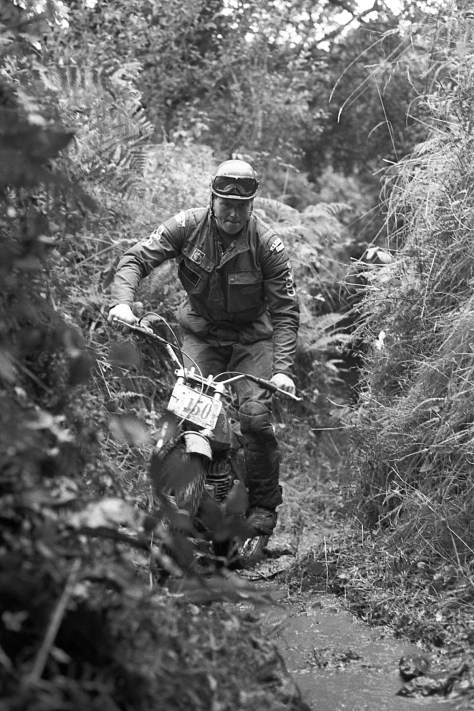
Finland’s Yrjo Vesterinen’s input to the Sherpa became more noticeable in the production model 199B, with the frame altered and now devoid of the rear mudguard loop, a new style swinging arm with tubing of a rectangular profile and painted white with sky blue fork sliders, fuel tank and side panels, which mirrored the colours in the Finnish national flag. It also had a much larger volume air-box than its predecessor.

By this time the factory finances were under severe pressure, but they produced a rare model with the ‘198B’ Sherpa, a five-speed 250cc model which utilised a frame similar to the larger six-speed 340cc 199B model for the French and UK markets only, none were originally sold in Spain and only 230 of these were manufactured for sale.



Various Bultaco Sherpa technical information:
Carburation: On the early model 10 Sherpa T, this was handled by IRZ, spigot mounted and clamped. The IRZ was a Spanish made carburettor which can trace back to fitment on pre-war Hispano-Suiza automobiles. Spain also made the AMAL (Amalgamated Carburettors fromed from Amac, Brown & Barlow and Binks companies) monobloc and concentric under licence, so eventually the Sherpa T used the 26mm AMAL instrument. It was later discovered by experimentation that the 325cc motor which was produced first in 1973 with the AMAL, that it ran well with a German made Bing, model 84 with 28mm venturi and this was adopted in 1975 on the production model 159.
A popular after-market fitment in the early 1970s was the Japanese Mikuni VM type, originally sourced from road machines, but these were found to give good results when fited to a Sherpa. Sammy Miller’s company introduced a Mikuni upgrade kit for the Sherpa to compliment his Hi-Boy frame kits and other after market products aimed at Bultaco owners who wanted to personalise their machines.
Kick-start levers: Hardly a major or even an exciting component, but there were different types used over the years on Bultaco Sherpas. The model 10 had a kick lever of which the splined crank part was slightly ‘S’ shaped in profile and this was used up until the model 49. For the 1971 Model 80, a straight profile lever was employed right up until the model 199A in 1979, which used a drop forged lever which was wasted.

All Sherpa kick-starts had a folding kicker bar for the foot, which employed a small ball bearing and spring enabling them to sit folded in when the machine was in use. There was a rubber sleeve with the companys thumbs-up logo fitted on the kicker bar.
The factory riders used a ‘sliding’ lever kicker bar of the type used on the small capacity Bultaco Tiron model. These are quite hard to find now, but give a Sherpa a ‘works’ look. The Sherpa up until 1977 always was produced with a gear-change on the right and rear brake pedal on the left. US traffic laws insisted that this was reversed.
However, Paco Bulto had his own theory as to why the left foot braking was more natural.
Yrjo Vesterinen: “Senor Bulto explained it to me, he said that there is a nerve connection between the left arm and the right leg, and vice versa. In other words, the left arm knows what the right leg is doing. Clutch to gear change, brake to brake. He said that this is the natural way for humans and the Japanese got it wrong! He demonstrated this by walking along and swinging his arms back and forth. I immediately tried it myself and I agree!“.
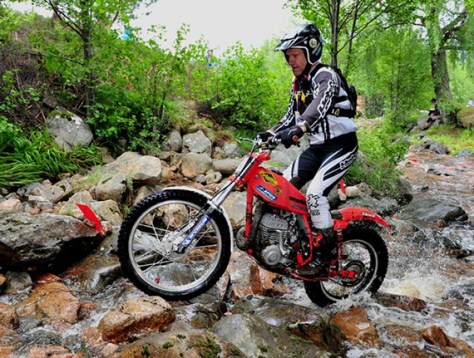
Comerfords’ Bultaco Wizard – Reg May
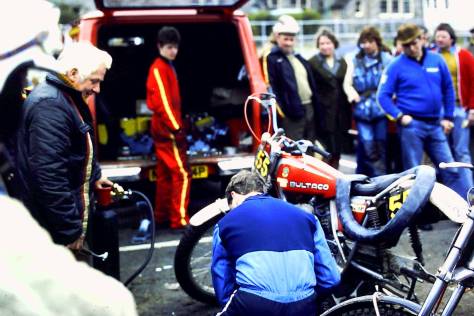
Reg J. May was a long serving member of the Comerfords’ staff at their busy Thames Ditton workshops in Surrey. May was himself a very handy trials and scrambles rider in his day and it was believed that he could set-up a Bultaco Sherpa T better than the factory.

He had a knack of getting the timing and carburation just spot on. A ‘Reg May prepared’ Bultaco was most definitely a machine to have.

Reg May did not have the benefit of CNC type machinery available to him, but he was very adept at fashioning sheet metal and altering frames, being a first class welder.

Reg was ‘spannerman’ for all the top Bultaco riders from, or based in, the UK. His reputation was second to none.

Factory rider and first world champion, Martin Lampkin put his 100% trust in Reg May’s judgement and Reg was a formidable force behind the riders, given that his preparation techniques were proven and backed up by years of ‘hands on’ experience. Nothing satisfied Reg May more was to see one of his well-prepared Bultacos take the win.

Reg May had a particular way of doing things. Before his death in 2015, Albert John ‘Buttons’ Button told Trials Guru’s John Moffat: “At the Scottish Six Days, when all the crowds were milling around watching the fettling sessions, Reg would hold us young lads back and say, hold on, wait until everyone has left the area … now go back to the bike and do the job properly”.

In 1981, Comerfords decided to make 40 special Sherpas using production model 199B with frames, modified by May, similar to that used by Yrjo Vesterinen.

These have become known as the Comerford 340. The rear swinging arm pivot was moved much closer to the motor and had a longer swinging arm assembly fitted to match.
John Reynolds rode a special Comerfords Bultaco 340 in 1983 which had been built by Reg May on a freelance basis. It had some innovative features. Reg had managed to move the swinging arm pivot very close to the final drive sprocket. This was achieved by mounting the winging arm pivots on two independent mounting ‘bobbins’ mounted on the frame. The swinging arm spindle was effectively dispensed with as was the rear engine mount assembly.
A special snakey exhaust system was used with the back box lowered to the footrest area on the off-side of the machine using modified Bultaco components. The swinging arm was a modified Bultaco Pursang item on the final version. The much modified machine was debuted at the Manchester 17 club ‘Dave Rowland Trial’ where Reynolds came home in a creditable third position.

…
Yrjo Vesterinen on his final Bultaco Sherpa in 1984: “It had taken about six months to get from what started as a standard 199B model to the last Bultaco I rode. It was always very much a ‘work in progress’ machine. It was never fully finished to the level that Reg May and I had hoped for. In order to achieve that, we would have needed to fabricate a brand new frame, using the measurements of the prototype bike. I never liked the look of it, as it was untidy. It was also much heavier than it could have been, as some of the components were made out of steel and could have been plastic or aluminium if we had the time and the resources available to us. As far as I am concerned it could have been an important stepping stone towards a much improved Bultaco Sherpa for the future. We were prepared to let the factory have it to produce a new model. It didn’t happen as the factory closed and it never was a finished article“.
…
Bultaco Sherpa Restorations and machines still in use:
Before:



After restoration work:




More Sherpas in private collections:




Beyond Bultaco:
‘Sindicatos’
The company that manufactured Bultaco motorcycles started to have increased financial problems in the petroleum crisis between 1978 when the Shah of Iran was deported from Iran and 1980 when the Iran-Iraq war broke out. Spain then started down the democracy route once more and in many companies the workers ‘sindicatos’ started to gain a lot of strength and power.
Petroleum became very expensive and labour in Spain experienced a period of unrest, giving constant problems due to the new rights with many strikes.
Bultaco ran out of money and Paco Bultó subjected to the new labour laws had to compensate the workers which cost a considerable sum in money. Eventually, he decided to give the workers the company and retired. Bultaco was effectively converted into a workers’ cooperative.
All was not well however, the workers fought amongst themselves, they shorten their working day, and increased their salaries. They were their own boss so the factory went down quickly.
In 1980, Bultaco had accumulated debts of around 5,000,000€ (800 million pesetas). Honda, Suzuki and Puch Austria were interested in buying Bultaco, but the workers resisted and wanted to convert into a cooperative, managed by the socialist and communist syndicates.
Bultaco – The Finale?
The death throes of Bultaco CEMOTO as a motorcycle manufacturer occurred in 1984. When compiling this tribute to the brand, we were curious as to exactly what went wrong? We knew about the now legendary ‘Sindicalista’ (workers union) model, a description coined by the Bultaco employees, which was the last of the Sherpa T – model 199B line.
We accept that nothing lasts forever, whether that is a motorcycle manufacturing company or any other entity for that matter.
There are many theories in books, articles, journals and the internet as to why companies and corporations fail or are taken over. It is always difficult, some say impossible, to find the truth, there are always two sides to a story in most, if not all cases. The facts are hard to assimilate and where is the ultimate proof? The Bultaco failure is no different. Nothing is that simple and is usually highly politically charged, regardless of nationality involved. Blame is usually universal.
Those that are passionate about the Bultaco brand some 30 years or more since it’s disappearance from the competition scene perhaps don’t want to know more about the demise of the once proud company that made Bultaco Motorcycles for the world’s marketplace, but the story of Bultaco would be incomplete without some sort of mention.
So with the help of Spanish enthusiasts of the marque, we will attempt in as pragmatic and factual manner as is possible, present another side of the Bultaco story which some may take to task; argue; discuss and perhaps either accept; reject or even completely disagree with.
But the name Bultaco and its trading marks have miraculously lived on in different forms, but it is so much different from the halcyon days when Paco Bultó’s dream became a reality in 1958 with the first Bultaco Tralla 101 rolled off the small production line and the company won world championships.
Here we present a recount of the timeline of the demise of Bultaco.
The working life inside Bultaco in three decades:
1959 – 1970: The paternalistic approach, this would be listening and helping the workers individually to their specific needs. In effect a benefactors approach to labour relations. The owners and management made you feel a member of the big Bultaco family. It was a family owned enterprise and that family extended into the workforce. There was an annual draw of a motorcycle between the workers, and a nice gift to celebrate Christmas for every worker. From those who knew the enthusiastic Paco Bultó, he was a man that got the best out of people and workers were people.
However, the late 1960s saw Bultaco commence with overtime working to increase production and improve productivity. Thereafter the first friction between worker and owner surfaced.
1971 – 1979: Confrontations emerged and festered in the company, owners versus workers. The first clandestine newsletter produced for and by the employees with the provocative title ‘Crazy Horse’ was published in 1971. One must appreciate that General Franco’s dictatorship was by now in its final days and worker’s unions were also clandestine.
Management responsibilities and day to day operations lay in the hands of persons such as Senors. Nomen; Chalamanch; Caballero and Gimeno. In 1976 there were two socialist unions at the factory in the form of CCT and CNT workers. That year, workers locked themselves inside the company to protest against some dismissals motivated by the crisis. This ended with the management lockout of the Company in December 1979, motivated by the refusal of workers to downsize the number of employees. To put this into perspective, the same number of workers produced 25,000 motorcycles for the US market in 1974, compared with in 1976 only 16,000 – in effect a 36% reduction in productivity.
In the second issue of the workers’ newsletter ‘Crazy Horse’ in 1972, the workers claimed an extra 500 Pesetas (2,68€) of weekly pay for all staff. Two years previously, Seat car workers were fighting exactly for the same increase.

1980 – 1984: It was this at the beginning of this period that the Bultó family ceased to recognise Bultaco as their family concern. Suspension of payments in April 1980 (liabilities of 800 million pesetas, almost 5,000,000€). Workers proposed in the June to establish a cooperative venture. In July, 1980 production restarts once more with Snr. Chalamanch as the general director.
The factory languishes with a politicized environment inside it. This would be the final nail in the coffin for Bultaco, described as simply a mess. Some workers in the spare parts department viewed the situation as a good opportunity to increase their salaries. Finally the factory commenced the operation called ‘Puntilla’ (in Spanish these are the sharp knives used to kill the cattle in the slaughterhouse and the swords used to terminate bulls in Spanish bullfighting); The ‘Puntilla operation’ was the sale of the last complete motorcycles, machinery and parts to ‘Rectificados Bellavista S.L’, a Company formed in Barcelona, still in existence, that continues to supply some Bultaco parts in the present day.
The question could be asked: Do you think that the Workers Committee distributed the money among the other workers? The answer would have to be, probably not. It would fall way short of what might have been termed ‘an equitable distribution’.
In life, and in any collective organisation, the loudest voice that you can hear is that of the extremist, but beyond logical claims or the usual ‘class struggle’, what happened in Spain then went further. Some still hold the point of view that labour issues can instil bitterness and hatred within organisations. However, one must balance this view by taking into account an opposing view. Spain was ruled by a right-wing dictatorship, worker’s unions were banned under Franco’s regime, only the right-wing worker’s unions were permitted and the clandestine unions were in effect leading the resistance. They became trusted among the general population, similar to the Communist party.
We believe that such feelings did not emerge suddenly or overnight. In Bultaco in the early 1970s, the heat inside the factory at San Adria de Besos was described as insufferable by the workforce – the workspace described like a stable, the payment regarded as a meagre salary, the chief of staff Ricardo Gimeno, likened to a ‘gunslinger’, and the Bultó family likened to the Mafia. These were all opinions at the time. However there are those that enjoyed their working lives at the factory, happy with their lot.
In the mid-1970s, the factory must have been similar to a pressure cooker. Perhaps the people in charge were not very receptive, or the paternalistic philosophy that F.X. Bultó subscribed to was no longer valid, but Bultaco had a particularly hard and uncompromising workers union that for sure, other similar companies such as the rival Montesa or car manufacturer Seat, perhaps did not have. However Bultaco was not unique there were large strkes in the region. Montesa and Seat were large companies and played a lead role in the resistance against the right-wing Franco regime. Seat, a public company, was eventually purchased by Fiat.
These were turbulent years, with uncertainty in every walk of life. To compound matters, Paco Bultó had suffered his first heart attack in 1976. The following year his brother was killed by terrorist activity. Perhaps Bultaco in the final years was left to die, and when someone made serious attempts to rescue it, there were too many other more pressing concerns for governments in Madrid and Barcelona to be concerned with?
The conversion of Bultaco CEMOTO to a cooperative was the easiest solution, but the result always seems to be the same – the end of companies. Here we have the example of the great British industry: Norton, BSA, Triumph together and strongly supported by the government and manufacturing in Meriden as a workers’ co-operative. The British motorcycle manufacturers’ adventure lasted little more than the Spanish Bultaco and also ended with a resounding bankruptcy. Later, it was a private initiative that worked the resurrection of the Triumph brand.
As far as is known, there is only one clear case where a government has saved a motorcycle brand and that was in the United States of America. The Ronald Reagan administration took protectionist measures in 1983 to prevent the closure of Harley Davidson. The formula was to apply for a 5 year period, a tariff, by a sliding scale rate from 49.4% down to 14.4% applied to any Japanese motorcycle imports above 700 cc. Compare that with Spain with their market that was completely closed to Japanese motorcycle imports until 1982, this explains the reason why there were no trial model Yamahas, Hondas, Suzuki or Kawasaki in Spain, except for a few private imports following the classic trials boom in the year 2000 and beyond.

It is factual that companies, Honda, Suzuki and the Austrian Puch when knocking on the doors of Montesa and Avello, were also interested in purchasing Bultaco. Once again, the worker’s unions refused to talk about any staff reductions and what they achieved was to thwart any attempt to revive Bultaco, making it an impossible mission. But we consider the thought that even more than an oversized workforce, what really frightened the Japanese most of all, was a belligerent, hostile and uncompromising environment among the workforce. To buy Bultaco would have been likened to put your feet into boiling oil.
Maybe it is pride, maybe it is patriotism, but this happened and continues to happen in Spain since the demise of Bultaco. To outside observers, employees seem to prefer to close a company rather than to work with interested parties for it salvation and save it when in a major crisis. It seems a great pity, because in the end there were no more Bultaco motorcycles, no new models released.
Of course whether you agree or disagree with the above assessment of the Bultaco Finale – it is entirely up to you.
Bultaco now:

…
…
The emergence of the ‘Bultaco 1959’ brand as a fashion icon occurred in 2005 with a lifestyle clothing and accessory range from Spain. This was a new departure from motorcycle manufacturing, but not by the old Bultaco firm. The Bulto family still held the name and thus the royalties from using that name for the clothing brand Bultaco 1959.

The clothing and accessory brand was to be sold throughout Europe.

And more to follow when we cover the rejuvenation of old Sherpas in the hands of Jose Luis Rodriguez – ‘El Puma’ (Puma Racing) and Rafa Vazquez (Vazquez Racing).




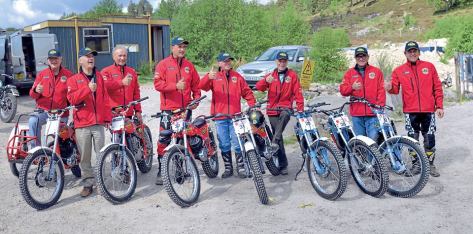
…
Bultaco Revival:

In the UK, there is a region known as Cumbria in North West England where the enthusiastic Westmorland Motor Club was founded in 1910.

The club decided in 2017 to run a new event near Sedbergh and called it ‘Bultaco Nostalgia Revival’.

It was attended by Yrjo Vesterinen; Charles Coutard, Jaime Puig, Javier Cucurella, Manuel Soler, Ignacio Bulto and Oriol Puig Bulto. In fact the team which attended the Highland Classic in 2013.

Many riders entered on the marque and a great day was had by all. It is intended to continue this event annually, to keep the Bultaco brand alive.

…

…
Some interesting ‘modified’ Bultaco Sherpas:

Other Trials Guru Articles on Bultaco:
Francesco ‘Bambi’ Valera – Bultaco Technician
Bultaco – Keeping the brand alive!
In the united Kingdom there is now the Bultaco Club UK which aims are to keep the brand alive. Full details are available HERE
Trials Guru and the Bultaco connection:
Trials Guru’s founder, John Moffat has had a long association with the marque Bultaco and the Sherpa T. He acquired a model 80 Sherpa T first in 1974 and has had at least one Sherpa T in his possession ever since!

Moffat rode the 1971 model 80 in the 1977 Scottish Six Days Trial, with the specification slightly upgraded.

He is friends with Jock Wilson who was with Comerfords International at Thames Ditton when they were the official importers of the marque and was also friendly with tuner, Reg May and stores-man Brian Green. Moffat later struck up a friendship with John May, son of Reg and in September 2016 with full cooperation of the May family wrote a comprehensive article on Reg May for Classic Trial Magazine Issue 18.

Bultaco has been almost a life-long affair concerning Trials Guru’s Moffat, which continues to this day, he rides and restores Bultaco Sherpa, purely for the enjoyment of the marque.


Moffat was one of the first in Scotland to purchase a Sherco Two-Fifty in the year 2000 from dealers Lewisport.


With special thanks to: Yrjo Vesterinen, Jock Wilson, Oriol Puig Bultó, Eric Kitchen, Mick Andrews, Lane Leavitt, Cristina Valera Fandos, Ramon Codina, Blackburn Holden V, Gilles Escuyer, Manuel Soler, Steve Saunders, Steve Wilson, the late Albert John ‘Buttons’ Button, Mike Rapley and all the photographers listed below for their co-operation in the preparation of this dedicated Trials Guru feature to Bultaco Motorcycles.
We would like to thank John Hulme of Trial Magazine UK/Trials Media for special and unlimited access to the private ‘John Hulme Catalogue Archive’ for imagery of Bultaco Sherpa T models over the years, used in this Trials Guru production.
© – All text copyright and Images as indicated: Trials Guru / Moffat Racing, John Moffat – 2017.
© – Image: World-wide Copyright and by special arrangement – Eric Kitchen, England (All Rights Reserved) – 2017.
© – Image: World-wide Copyright Mercedes Gou/Motocat, Barcelona (All Rights Reserved) – 2017.
© – Image: World-wide Copyright Heath Brindley, Bristol (All Rights Reserved) – 2017.
© – Image: World-wide Copyright Ramon Codina, Bultaco Sport Classic, Barcelona (All Rights Reserved) – 2017.
© – Image: World-wide Copyright Steve Saunders, Gloucester, UK (All Rights Reserved) – 2017.
© – Image: World-wide Copyright Robert & Michael Little, Peebles-shire (All Rights Reserved) – 2017.
© – Image: World-wide Copyright Torbjorn Eyre, Macclesfield (All Rights Reserved) – 2017.
© – Image: World-wide Copyright Mike Rapley, Carnforth, England (All Rights Reserved) – 2017.
© – Image: World-wide Copyright Iain Lawrie, Kinlochleven (All Rights Reserved) – 2017.
© – Image: World-wide Copyright Iain C. Clark, Fort William (All Rights Reserved) – 2017.
© – Image: World-wide Copyright David Coughlan, Waterford, Ireland (All Rights Reserved) – 2017.
© – Image: World-wide Copyright Lane Leavitt/ Debbie Evans-Leavitt, California, USA (All Rights Reserved) – 2017.
© – Image: World-wide Copyright Neil Sturgeon, Darlington (All Rights Reserved) – 2017.
© – Image: World-wide Copyright John Honeyman, Fife (All Rights Reserved) – 2017.
© – Image: World-wide Copyright Jimmy Young, Armadale (All Rights Reserved) – 2017.
© – Image: World-wide Copyright Rainer Heise, Germany (All Rights Reserved) – 2017.
© – Image: World-wide Copyright and special permission, Mr. Barry Robinson of Ilkley, West Yorkshire (All Rights Reserved) – 2017.
© – Image: World-wide Copyright Blackburn Holden V, Yorkshire (All Rights Reserved) – 2017.
© – Image: World-wide Copyright Fiona Watson, Aberdeenshire (All Rights Reserved) – 2017.
© – Image: World-wide Copyright Chris Sharp, Belfast (All Rights Reserved) – 2017.
© – Image: World-wide Copyright Norman Hawkins, Wales (All Rights Reserved) – 2017.
© – Image: World-wide Copyright Colin Goode, Bedlington (All Rights Reserved) – 2017.
© – Image: World-wide Copyright Donald Young, Stonehaven, Scotland (All Rights Reserved) – 2017.
© – Image: World-wide Copyright Marta Prats Fabregas, Barcelona (All Rights Reserved) – 2017.
© – Image: World-wide Copyright Toon Van de Vliet, Netherlands (All Rights Reserved) – 2017.
© – Image: Publicity material, Bultaco Brinco R – World-wide Copyright bultacobrinco.com (All Rights Reserved) – 2017.
Trials Guru: Main Index
INTERACTIVE TRIALS GURU:
Comments by Trials Guru followers:
George Q Adams from the USA commented:
In 1970 I saw my first Sherpa T in the Carson National Forest of the Rocky Mountains. I was mesmerized by how they climbed steep, treacherous inclines effortlessly at low rpms. Being a motocrosser of some repute, I was puzzled by the dichotomy of the obviously high torque at low RPM of the Sherpa versus the high RPM and lower torque of the Pursang I was used to. Now, decades later, I’m living in the mountains and ride my 191, 159 and 125 Sherpas in those same Rockies. I’m almost 70 now but I stay in shape and ride a lot. At 10,000 feet elevation I have to get out my 105 and 110 jets but the Sherpas never miss a beat. I will soon apply for membership in the “Rocky Mountain Trials Association”. I will admit to dusting off the 121 and 134 Pursangs from time to time at the MX venues. In fact, I made the Dallas Morning News sports page 21 years ago when I won the Texas Vintage Racing Club Amateur MX class in 1996: “48 year old Dentist shows the 20 and 30 year olds the fast line”. Big fun. I love my Buls!
…
If you wish to contact us about this ‘Bultaco – Spain’ special section, please do so using the contact online form here:



